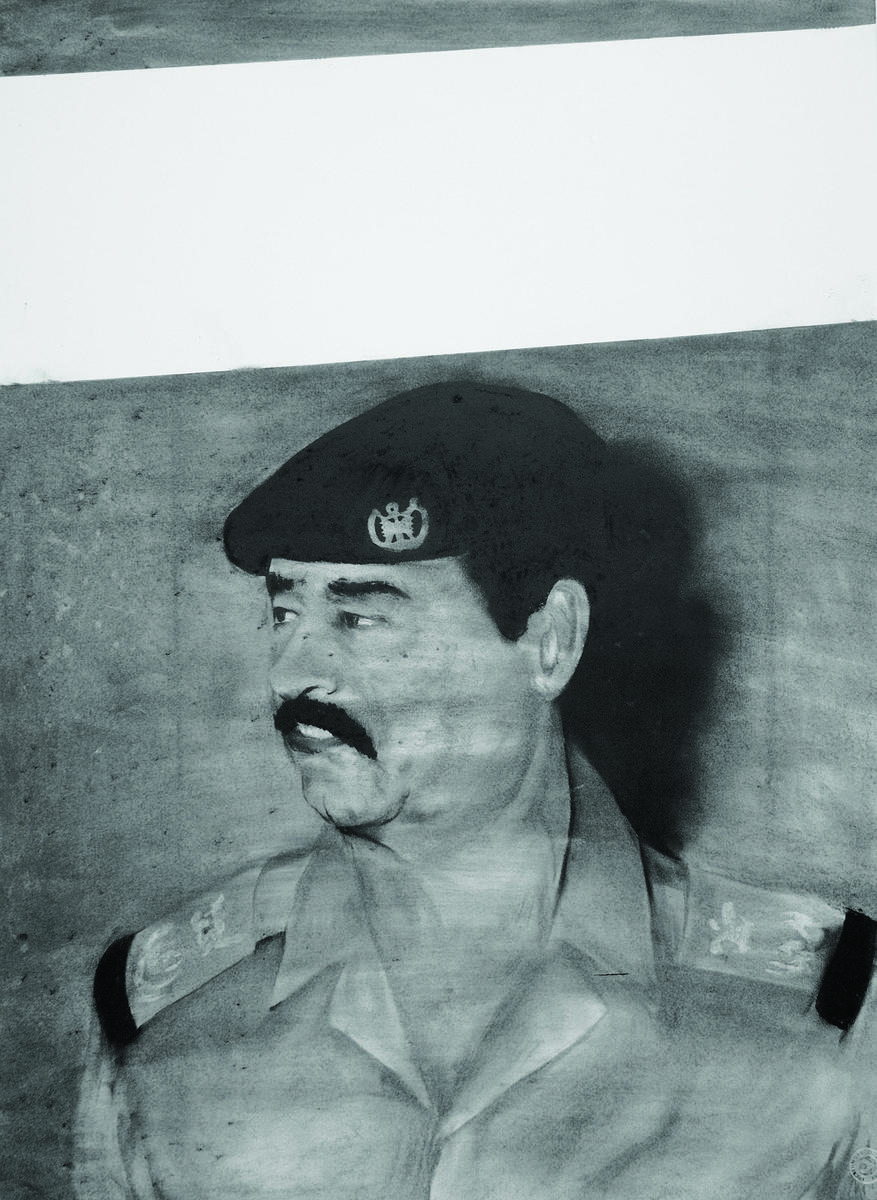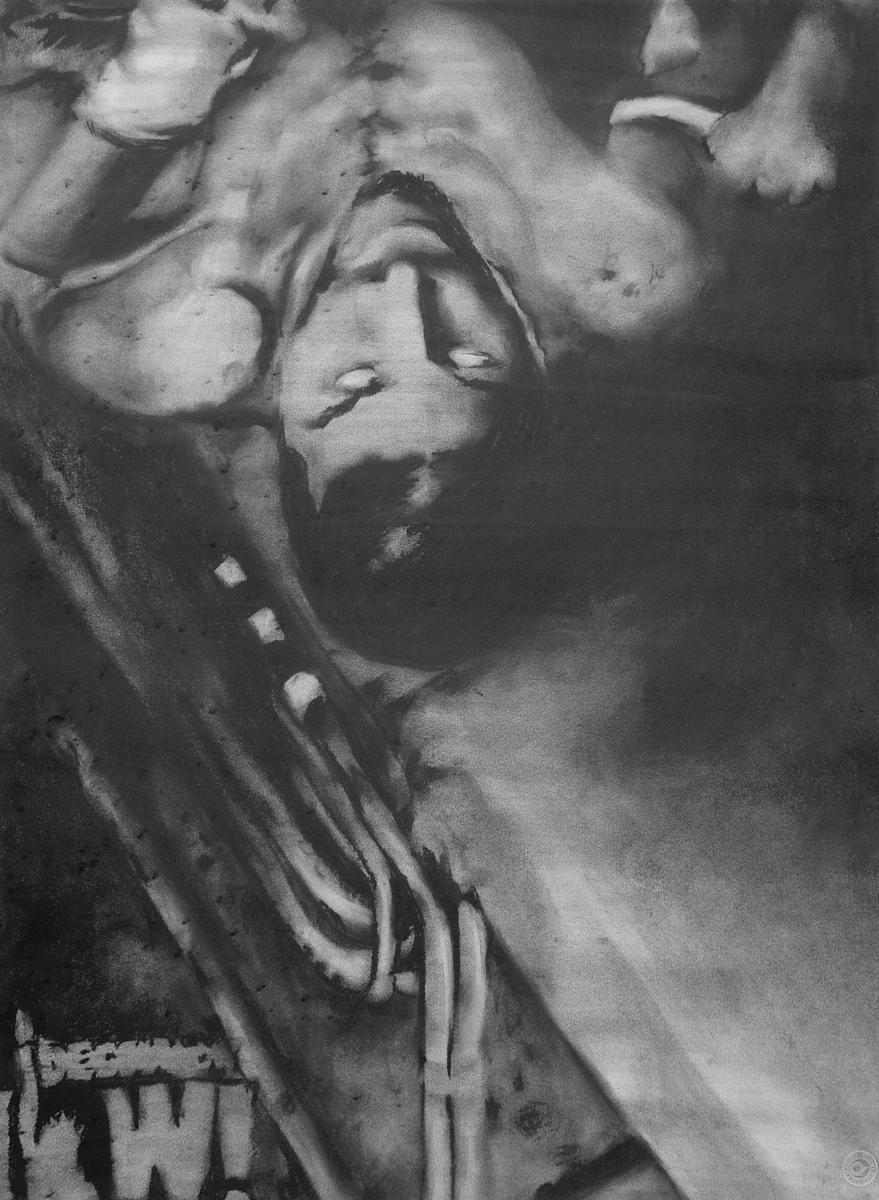
Negar Azimi: You’ve created a series of works revolving around a number of speeches Saddam Hussein delivered in the 1990s on the unlikely theme of democracy. Where did you find these speeches?
Paul Chan: A wonderful writer and a former organizer for Voices in the Wilderness, the Chicago-based activist group, showed them to me. They were given to him by an Iraqi friend in Baghdad who thought Jeff might find them interesting. When Jeff showed them to me, I freaked.
NA: How can you be sure they’re real?
PC: A little early for ontological questions, isn’t it?
NA: I mean, how can anyone “certify” them?
PC: Shiva Balaghi, who directs the Kevorkian Center for Middle Eastern Studies at New York University, helped me research these speeches. Her research assistant confirmed their presence in university archives at NYU and Columbia. It’s fair to say that these speeches are not rare. At a certain moment, Iraq and Hussein were active participants in the intellectual climate in the Middle East. So, like any aspiring academic, they published papers and gave speeches, translated them, and kicked them out into the world.
NA: Is it fair to rob them of context? What about putting them in some sort of home?
PC: What are you afraid of? That if people read the speeches without the tethers of its history that they will read them wrong? Can’t we be fairly certain that, regardless of how the speeches are framed, that at this point in time, they will always be read wrong? Isn’t that the most provocative thing about them?
I don’t propose to contextualize them at all. I don’t see the speeches as a kind of Rosetta Stone that would, if placed close enough to the constellation of knowledge about Iraq, help decipher its situation, much less alter its course as a nation and as an idea. Let’s see the speeches for what they are: ghosts; like Hamlet’s father, who is both a threat and a promise. My job is to visualize — or maybe hallucinate is a better word — the speeches as both threat and promise to the idea of democracy — here, or there, in charcoal on paper.
NA: Don’t you run the risk of fetishizing Third World dictatorships and their double standards? I mean, we know he sucks. And he’s a liar. So what? Look:
Nasser: “presidential democracy”
Sukarno: “guided democracy”
Trujillo: “neo democracy”
And these are military regimes only; the Soviet Union and China were “people’s democracies.” There’s a history of promiscuity associated with the term “democracy” and even with some of its most fundamental premises.
PC: Yes, it’s true. But you’re forgetting Nixon, Johnson and Reagan. And there are really two questions here. The first is, am I fetishizing Saddam? And the answer is, I’m too late. He was made into a fetish long before this project, and he himself wanted this. The second question is, can it really be that interesting to make drawings mutated by Hussein speeches on democracy, given that virtually every despot has used the concept of democracy as an ideological weapon? And the answer is, maybe not. But there isn’t a definitive answer, yet. If I were to simply see the drawings as illustrations for Hussein’s ideas on democracy, then they wouldn’t be very good drawings. But what if art is not used, like a chain, to connect and fetter? What if art is wielded like a razor, to separate and set free. As Gerhard Richter’s recent book War Cut tried to demonstrate, art does not have to serve knowledge or history. As a promise and threat to both, art figures its own path toward the reconciliation between the living, the dead and the dying.
NA: The drawings are eerie. What do you plan to do with them?
PC: I plan to do around forty drawings based on and mutated by the speeches. After that, I don’t know. A book? An indictment? They’re done in charcoal. 22” x 30.” I try to draw them fairly quickly.

NA: It’s odd that you render Abu Ghraib and abuse images in such a rudimentary way, when their very high-tech nature (i.e., digital photography, disseminated on the Internet) canonized them as brands of the Occupation and its associated abuses. Why create drawings like this?
PC: I’ve found photography and video increasingly distrusted in places where I’ve been with political struggles. This distrust stemmed primarily from the use of photography and video as tools for institutional power, whether it was on the part of the government, the military or the international news media. Perhaps, once upon a time we could count on mechanical representation as something beyond the pale of rhetorical framing; we could count on seeing as believing. But after Rodney King, I think this is impossible. And strangely enough, people have returned to drawing, almost court-room-style sketching, to document the places and situations of their lives. It makes sense economically. I didn’t meet one Iraqi with a 35mm camera, much less a video camera. But they didn’t give up on documenting what was happening to their country as the US prepared to, and did, invade. Drawing as a mode of representation challenges the institutional truth of recorded media. It’s David versus Goliath. Guess who I’m betting on?
NA: So there’s a definite upsurge in “political art,” whatever that means. Some of it leaves me uneasy; some work reeks of superficial appropriation of political themes and mantras that seem forced, hackneyed, not genuine, trendy? Am I wrong? Is there a measure of authenticity among these practices or is that a load of bullshit?
PC: Isn’t it funny how people debate the merits of political art the same way they talk about political correctness? I mean, haven’t we all met bigots who say something like, “I don’t want to be politically incorrect, but …” and then they go on to spell out something so vile that it makes us want to throttle them. Doesn’t both “political art” and “political correctness” function a lot like a straw man, or better yet what Jacques Lacan would call objet petit a, something that functions like a blindspot, which is why describing political art always comes with the caveat “whatever that means.” That’s how blind spots work; they blind us and hold our attention precisely by its invisibility. To what end? To blur the rest of the picture and to implicate us in the blurring of the rest of the picture.
NA: I think that’s an answer, however facile my question. Mark Danner has pointed out that the images created the scandal in the case of Abu Ghraib. Do you agree? If he’s right, what does this reveal about our image-programmed minds? I guess Slavoj Zizek would say that the very fact that these acts were captured on film reduces Americans to a bunch of fraternity brothers having a good time. Is this American culture? What does all of this have to say about the US, if anything at all?
PC: I agree with Danner. And I think the effect of the scandal disproved Sontag’s early ideas about how we would become so desensitized visually that nothing would be able to move us. She corrected herself in her last book, Regarding the Pain of Others. I think it was a hopeful sign that people were freaked out by the images and began to actively question what was going on. The questioning didn’t last as long as I would have liked and didn’t get rid of anyone of significance in the administration. But it was worth it.
As for Žižek’s assertion, I’m not sure if that was what he was after— the image of American culture as one big frat. Žižek has written some very incisive things about the many dimensions of the Iraq tragedy. In fact, the most important contribution he’s made is his notion of how fantasy is not something that escapes reality, but in fact shapes it, give reality a proper framework. So in a way we can say that the fantasy of America as “the frat of freedom” is what licensed the horrifying abuse at Abu Ghraib, whether or not there is any kernel of truth to the reality of this frat. But on the other hand, what Žižek teaches us is that getting rid of fantasy does not get us any closer to the truth of the situation. We should not revoke this license to fantasize for the sake of progress. Again, I think of Hamlet’s father. Is it important to know whether this ghost who speaks to Hamlet is real or simply a figment of his imagination? Obviously not. Hamlet doesn’t care either because he can’t trust the living to help him reconcile the past with the present. The living are all liars! So he takes a chance by listening to the living dead.